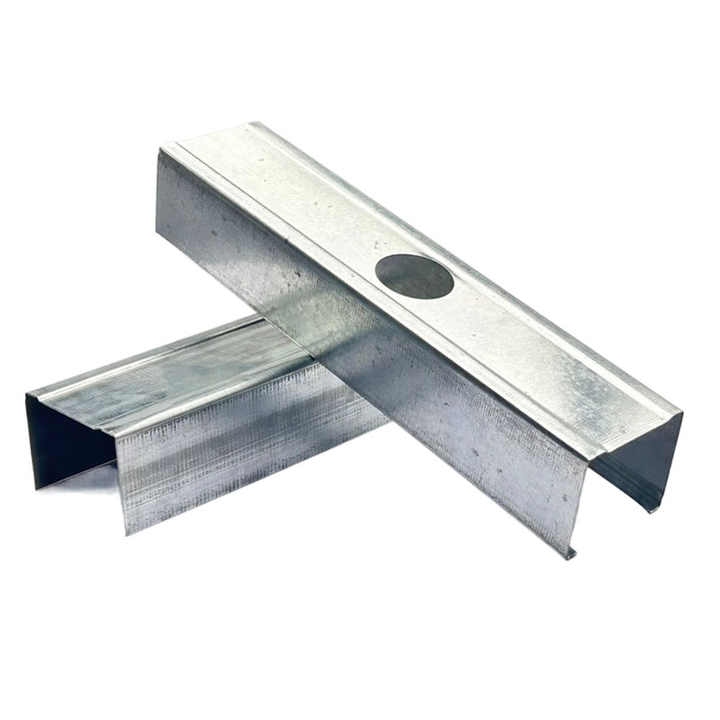Ceiling Grid
Drywall partition
Ceiling channel
Corner Wall angle
Accessories
Steel profiles
Support customization

Gypsum board drywall partition metal stud track
A gypsum board drywall partition system with metal stud and track framing is a popular solution for creating interior non-load-bearing walls. This setup is widely used in residential, commercial, and industrial buildings because it’s lightweight, easy to install, fire-resistant, and provides sound insulation. Here’s an overview of each component and how they work together:
Components of a Gypsum Board Drywall Partition with Metal Stud and Track
Gypsum Board (Drywall Panels):
Gypsum boards, commonly known as drywall, are the main material used to create wall surfaces. Made of a gypsum core sandwiched between layers of durable paper, they are lightweight, easy to cut, and available in different thicknesses and types (such as fire-rated, moisture-resistant, or soundproof).
They are attached to the metal framing (studs and tracks) to create a smooth wall finish ready for painting or other surface treatments.
Metal Studs (Vertical Members):
Metal studs are the vertical framing members placed between the floor and ceiling tracks. These studs are typically made from cold-formed galvanized steel, providing strength and rigidity to the wall structure.
Metal studs come in various widths (often labeled CW for "ceiling wall" and UW for "universal wall"), allowing different wall thicknesses to accommodate insulation, soundproofing, or other materials.
Studs are spaced at regular intervals, usually 16 or 24 inches apart, providing support for the gypsum boards.
Metal Tracks (Horizontal Members):
Top and Bottom Tracks: The horizontal tracks are U-shaped channels that are attached to the floor and ceiling, serving as the base into which the metal studs are fixed. They hold the studs in place and ensure the wall is stable and aligned.
Additional Bracing: In taller or specialized partitions, additional horizontal bracing or tracks may be used to enhance stability or prevent movement.
Fasteners and Accessories:
Self-tapping Screws: Used to secure gypsum boards to the metal studs.
Joint Tapes and Compound: These are applied to the seams between drywall panels to create a smooth, continuous surface.
Corner Beads and Finishing Accessories: Protect edges and create smooth corners for a finished look.
Advantages of Gypsum Board Drywall Partitions with Metal Stud Track
Durability and Strength: Metal studs are stronger and more durable than wood, offering better resistance to warping, shrinking, and moisture.
Fire Resistance: Gypsum board is inherently fire-resistant, and when combined with metal framing, it enhances the partition’s fire rating.
Acoustic Performance: Depending on the thickness and type of gypsum board, as well as the stud spacing and insulation used, these partitions can provide effective sound insulation.
Versatility: Metal stud and gypsum board systems are suitable for a wide variety of interior wall configurations and can easily integrate with electrical and plumbing systems.
Installation Process
Track Installation: Attach the top and bottom metal tracks to the ceiling and floor where the wall partition will be placed. Ensure these are straight and level.
Stud Placement: Insert the metal studs vertically between the tracks, aligning them according to the desired spacing (typically 16 or 24 inches on center). Secure each stud with screws to the top and bottom tracks.
Installing Gypsum Board: Attach gypsum boards to the studs using self-tapping screws. Stagger the joints on each side for increased strength and stability.
Finishing: Apply joint tape over seams, then coat with joint compound. Sand, prime, and paint or add desired finishes to complete the wall.
Applications
Office Partitions: Ideal for creating office cubicles and partition walls in commercial spaces.
Residential Interior Walls: Used for dividing spaces or creating rooms in homes, especially in moisture-prone areas like basements.
Soundproofing: Great for rooms where sound insulation is desired, such as conference rooms, hospitals, and schools.
A gypsum board drywall partition with a metal stud track framing system is a flexible, efficient, and durable choice for modern interior walls. It balances fire resistance, sound insulation, and ease of installation, making it a popular choice across a wide range of construction projects.
Selection Guide for Ceiling Channel Materials: A Comparison of Light Steel vs. Aluminum in Terms of L
In ceiling construction projects, ceiling channels serve as the critical framework supporting the ceiling surface layer, and their material selection directly impacts the project's quality and service life.
2025-07-06
Designing with Corner Wall Angles: Enhancing Room Aesthetics with Finishing Touches
Introduction In the world of interior design, even the smallest details can make a significant impact on the overall aesthetic of a room. One often overlooked area is the corner wall angles. These seemingly insignificant junctions between w
2025-07-03
Commercial-Grade Corner Wall Angles for Heavy-Duty Construction Projects
In heavy-duty construction projects such as industrial plants, large commercial complexes, and transportation hubs, corners are critical parts of the building structure that constantly face severe challenges. Frequent collisions from heavy equipment and e
2025-06-30
DIY Corner Wall Angle Finishing and Professional Results
In home decoration, DIY corner wall treatments have gained immense popularity among homeowners striving to elevate the quality of their living spaces. Corners are susceptible to damage and highly noticeable, so the way they are handled directly influences
2025-06-27

